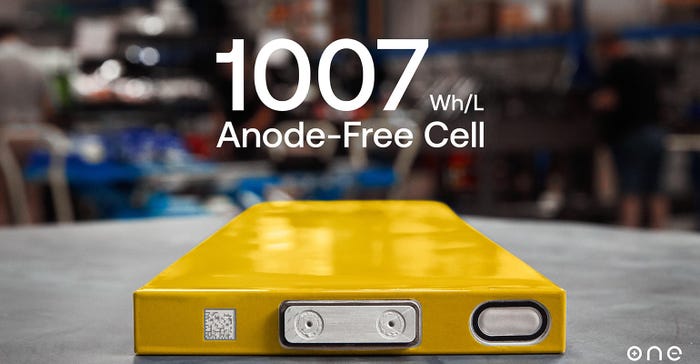Revolutionizing Battery Technology for 600-Mile Range EVs
Recent breakthroughs in battery technology are pushing the boundaries of EV range that could accelerate the adoption of electric vehicles.

As the demand for electric vehicles (EVs) continues to rise, one of the main challenges that automakers and consumers face is the range limitation of EVs. 600-mile EVs could overcome one of the main challenges for EVs: Range anxiety. Longer-range EVs would be more practical and convenient for long road trips. Traveling without worrying about running out of power before reaching the destination would take away the worries about finding the next charging stations along the way.
From improvements in battery chemistry and density to advances in charging infrastructure; let’s delve into some innovations overcoming range anxiety.
600-mile battery technology
Energy storage company Our Next Energy (ONE) claims that its anode-free cell is the highest energy density large-format cell ever produced. The 1007 Wh/L anode-free cell can enable a 600-mile “Gemini” battery architecture. ONE founder and CEO Mujeeb Ijaz stated, “We are pairing two chemistries together in dual battery architecture. We designed an EV that could travel 750 miles on a single charge.”
Gemini technology uses two cells: a lithium iron phosphate (LFP) cell for daily driving and an anode-free cell for longer trips. Gemini’s LFP cell delivers 441 Wh/L, which produces a range of 150 miles on a charge, and after 150 miles, it switches to the anode-free cell, using it to charge the LFP cell. With an energy density of 1,007 Wh/L, the anode-free cell provides an additional 450 miles of range.

Though all batteries have an anode and a cathode, an “anode-free cell” does not have a traditional anode, according to ONE’s website. Battery makers also use the term “anode” to refer to the active material placed on the battery’s current collector during the manufacturing process. This material may contain graphite or silicon. ONE creates an “anode” without this material. Instead, during “formation”—an essential step during which the battery is charged and discharged—small amounts of lithium plate onto the current collector. This process forms the anode in ONE’s “anode-free” battery.
”Our prismatic anode-free cell is produced with approximately half of current cell manufacturing equipment for equivalent capacity, allowing us to sharply reduce scale-up cost,” stated Ijaz.
EV fast charging advancements
Fast charging speeds are crucial for long-range EVs to be practical and convenient. With advancements in higher power outputs and improved charging protocols, it may be possible to charge an EV within a 600-mile range in a reasonable amount of time. But a widespread fast-charging infrastructure—especially along major highways and urban areas—that supports high-power charging is also critical.
Advancements in ultra-fast charging technology are critical enablers of the widespread adoption of EVs. With this technology, it becomes possible to charge EVs in a matter of minutes. Ultra-fast charging vehicles typically operate at higher voltages and currents than standard charging methods (they can provide up to 19kW). The technology can provide charging power levels up to 350kW or even higher.
Ultra-fast charging systems are becoming more efficient, meaning that more energy from the charging station is effectively transferred to the EV battery. This is possible due to advancements in power electronics, improved battery management systems, and enhanced charging protocols. Here are some examples of advancements in ultra-fast charging technology:
Tesla’s V4 superchargers: Tesla has started to deploy supercharger V4 stations in the Netherlands. Tesla’s latest generation of ultra-fast charging stations can deliver up to 600kW of charging power ( with a rated voltage of 1,000V and a rated current of 615A).

Electrify America’s fast charging stations: Electrify America’s hyper-fast charging stations can deliver up to 350 kW. The company expects to have more than 1,800 total charging stations with over 10,000 chargers in the United States and Canada by 2026.
About the Author(s)
You May Also Like


.jpg?width=300&auto=webp&quality=80&disable=upscale)


